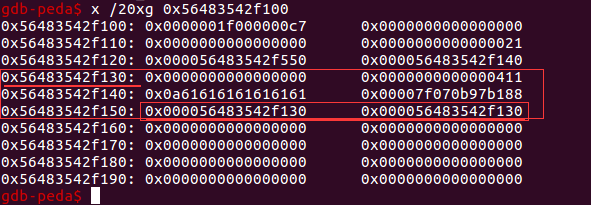ctf-HITCON-2016-houseoforange学习
目录
堆溢出点
利用步骤
创建第一个house,修改top_chunk的size
创建第二个house,触发sysmalloc中的_int_free
创建第三个house,泄露libc和heap的地址
创建第四个house,触发异常
一点疑惑
参考资料
堆溢出点

图1 堆溢出点
edit函数中没有对那么长度进行校验。
利用步骤
创建第一个house,修改top_chunk的size
top_chunk的size也不是随意更改的,因为在sysmalloc中对这个值还要做校验
assert ((old_top == initial_top (av) && old_size == 0) || ((unsigned long) (old_size) >= MINSIZE && prev_inuse (old_top) && ((unsigned long) old_end & (pagesize - 1)) == 0)); /* Precondition: not enough current space to satisfy nb request */ assert ((unsigned long) (old_size) < (unsigned long) (nb + MINSIZE));
所以要满足:
- 大于MINSIZE(0X10)
- 小于所需的大小 + MINSIZE
- prev inuse位设置为1
- old_top + oldsize的值是页对齐的
创建第二个house,触发sysmalloc中的_int_free
如果要触发sysmalloc中_int_free,那么本次申请的堆大小也不能超过mp_.mmap_threshold,因为代码中也会根据请求值来做出不同的处理。
if (av == NULL || ((unsigned long) (nb) >= (unsigned long) (mp_.mmap_threshold) && (mp_.n_mmaps < mp_.n_mmaps_max)))
如果请求的堆块大小nb大于等于mp_.mmap_threshold就可能走mmap分支,而不是扩展原来heap的大小了。
触发_int_free后,top_chunk就被释放到unsortbin中了。以下将它称作old_top。之所以要这样操作,是因为程序本身的限制,让我们不能分配到想要的内存区。
本身的限制:
- 一次操作的对象只能是最近一次创建的house指针
- 没有释放操作
通过这种方式,在空闲区有了堆块,也就存在了链表指针,通过一定的方式就拿到想要的数据了。
创建第三个house,泄露libc和heap的地址
本次创建house分配的堆块从unsortbin中分配,指定的大小要小于old_top,系统会将old_top切分成两块。
在把old_top从unsortbin链中取下后,会将其插入相应的largebin中
/* remove from unsorted list */ unsorted_chunks (av)->bk = bck;//将old_top从unsortbin中取下 bck->fd = unsorted_chunks (av); … victim_index = largebin_index (size);//计算old_top大小在largebin那个层次 bck = bin_at (av, victim_index); fwd = bck->fd; … victim->fd_nextsize = victim->bk_nextsize = victim;//将old_top的fd_nextsize和bk_nextsize都指向old_top本身 … mark_bin (av, victim_index); victim->bk = bck; victim->fd = fwd; fwd->bk = victim;//将old_top加入largebin链表中 bck->fd = victim;
在后面分割堆块后,保存有指针信息的堆块会被分配给用户,而且这些信息malloc不会擦除。

图2 old_top加入largebin链表中
剩下的堆块(下文依然称之为为old_top)又被加入到unsortbin中了。
然后输入8个字节,调用see函数,那么bk处保存的指针信息就得到了。这个就是unsortbin的地址,这个地址处于libc中,减掉一个偏移就是libc的起始地址了。
重新输入24个字节,调用see函数,那么bk_nextsize处保存的指针信息就得到了。这个是本次分割前的old_top块起始地址。减掉一个偏移就是heap的起始地址了。
为第四步触发异常布局内存。
本题的利用思路,是通过修改IO_list_all指针来控制异常处理的流程到我们指定的函数。如何触发异常,第四步会说。
while ((victim = unsorted_chunks (av)->bk) != unsorted_chunks (av)) { bck = victim->bk; … unsorted_chunks (av)->bk = bck; bck->fd = unsorted_chunks (av);
IO_list_all的地址需要拿到libc.so后才能确定。通过覆盖此时的old_top的size域和bk指针,来重写IO_list_all。
将bk指针覆盖为&IO_list_all -0x10,因此IO_list_all被重写为unsortbin-0x10。
将size域设置为0x60。为什么是0x60而不是70、80呢?
先来看看,设置为0x60后会给后续的malloc造成什么影响。
unsorted_chunks (av)->bk = bck; bck->fd = unsorted_chunks (av); … if (in_smallbin_range (size)) { victim_index = smallbin_index (size);// victim_index=6 bck = bin_at (av, victim_index);//bck=&av->bins[10]-0x10 fwd = bck->fd; } … mark_bin (av, victim_index); victim->bk = bck; victim->fd = fwd; fwd->bk = victim;//old_top被加入av->bins[10]的链表中了。 bck->fd = victim;
0x60属于smallbin的范围了,所以此时的old_top被加入到smallbin[4]的链表中。又为何要加入到smallbin[4]中呢?此时IO_list_all=&unsortbin-0x10,距离smallbin[4]的偏移是0x60,再来看看IO_FILE的结构体
struct _IO_FILE { int _flags; /* High-order word is _IO_MAGIC; rest is flags. */ #define _IO_file_flags _flags /* The following pointers correspond to the C++ streambuf protocol. */ /* Note: Tk uses the _IO_read_ptr and _IO_read_end fields directly. */ char* _IO_read_ptr; /* Current read pointer */ char* _IO_read_end; /* End of get area. */ char* _IO_read_base; /* Start of putback+get area. */ char* _IO_write_base; /* Start of put area. */ char* _IO_write_ptr; /* Current put pointer. */ char* _IO_write_end; /* End of put area. */ char* _IO_buf_base; /* Start of reserve area. */ char* _IO_buf_end; /* End of reserve area. */ /* The following fields are used to support backing up and undo. */ char *_IO_save_base; /* Pointer to start of non-current get area. */ char *_IO_backup_base; /* Pointer to first valid character of backup area */ char *_IO_save_end; /* Pointer to end of non-current get area. */ struct _IO_marker *_markers; struct _IO_FILE *_chain; …
可以看到,IO_FILE偏移0x60的字段是struct _IO_marker *_markers,偏移0x68的字段是struct _IO_FILE *_chain。而这两个的值恰恰是old_top的起始地址。
原来改为0x60是为了将old_top加入smallbin[4],而smallbin[4]的fd和bk指针恰好对应于IO_FILE结构体中的_markers和_chain字段。这个时候,算是明白参考文章所说,无法控制main_arena中的数据,但是通过chain链,将控制转移到我们到我们能控制的地方。

图3 IO_list_all被重写后
那如何使用chain字段呢?
while (fp != NULL) { … fp = fp->_chain;
当fp指向old_top的时候,那一切都好说了。为了使用vtable,我们还要过一段校验代码。
if (((fp->_mode <= 0 && fp->_IO_write_ptr > fp->_IO_write_base) #if defined _LIBC || defined _GLIBCPP_USE_WCHAR_T || (_IO_vtable_offset (fp) == 0 && fp->_mode > 0 && (fp->_wide_data->_IO_write_ptr > fp->_wide_data->_IO_write_base)) #endif ) && _IO_OVERFLOW (fp, EOF) == EOF)
- fp->_mode <= 0不成立,所以
- _IO_vtable_offset (fp) == 0、fp->_mode > 0和fp->_wide_data->_IO_write_ptr> fp->_wide_data->_IO_write_base必须成立
- 我们将vtable的值改写成我们构造的vtable起始地址
- 将_wide_data字段改写成IO_FILE中字段_IO_read_ptr的地址 //此处错误,在参考的利用脚本中并不是改成_IO_read_ptr的地址。而是vtable前0x28个字节,这些字节恰好能满足fp->_wide_data->_IO_write_ptr> fp->_wide_data->_IO_write_base。当然,也可以改成IO_FILE中字段_IO_read_ptr的地址,但是在payload中需要额外构造一些数据来满足条件了
而传递给over函数的参数是fp,fp指向old_top,起始处被写为”/bin/sh\0x00”
创建第四个house,触发异常
如上面第三步所述,old_top的size被改写为0x60,本次分配的时候,会先从unsortbin中取下old_top,加入到smallbin[4],同时,unsortbin.bk也被改写成了&IO_list_all-0x10,所以此时的victim->size=0那么不会通过校验,进入malloc_printerr,触发异常。
一点疑惑
关于前面调用_int_free将old_top释放到unsortbin我是一笔带过。但是这个地方有一点问题。
old_size = (old_size - 4 * SIZE_SZ) & ~MALLOC_ALIGN_MASK; set_head (old_top, old_size | PREV_INUSE); chunk_at_offset (old_top, old_size)->size = (2 * SIZE_SZ) | PREV_INUSE; chunk_at_offset (old_top, old_size + 2 * SIZE_SZ)->size = (2 * SIZE_SZ) | PREV_INUSE; if (old_size >= MINSIZE){ _int_free (av, old_top, 1);
old_top被释放之前,用最后的0x20个字节构造了两个chunk的header信息。size都设置为2 * SIZE_SZ。但是就是这里有问题。
nextchunk = chunk_at_offset(p, size); nextsize = chunksize(nextchunk); if (__builtin_expect (nextchunk->size <= 2 * SIZE_SZ, 0) || __builtin_expect (nextsize >= av->system_mem, 0)) { errstr = "free(): invalid next size (normal)"; goto errout;
这个校验会不通过。但是事实却是通过了。很困惑。不知道自己哪点理解出现了偏差。
近来才想起来还有这个问题没处理,其实代码已经告诉我答案了。
chunk_at_offset (old_top, old_size)->size = (2 * SIZE_SZ) | PREV_INUSE;
此时size设置了prev_inuse位,自然在后面的校验中大于2 * SIZE_SZ
__builtin_expect (nextchunk->size <= 2 * SIZE_SZ
参考资料
[1] CTF Pwn之创造奇迹的Top Chunk
http://bobao.360.cn/ctf/detail/178.html
[2] HITCON CTF Qual 2016 - House of Orange Write up
http://4ngelboy.blogspot.jp/2016/10/hitcon-ctf-qual-2016-house-of-orange.html
[3] glibc-2.23源码



